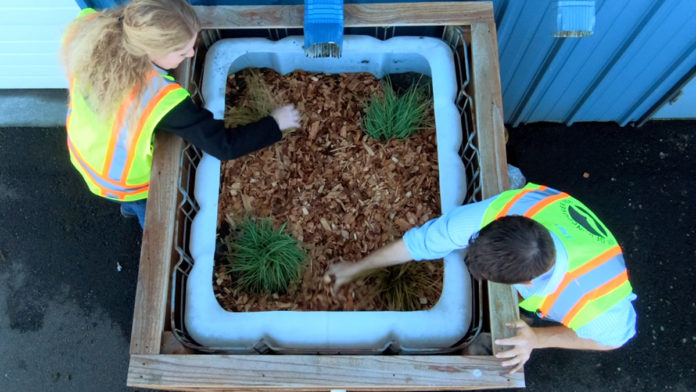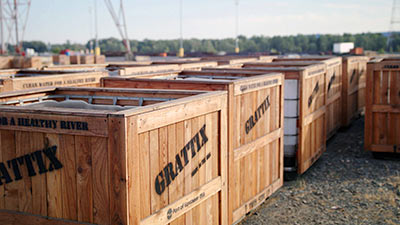
When the Port of Vancouver USA’s Mary Mattix and Matt Graves first invented the Grattix – a homemade contraption to clean stormwater runoff – they were hoping to reduce the amount of zinc pollution coming from rooftops at their facility.
But the popularity and success of the device, which works like a rain garden in a box, has been catching on both at the Port and at industrial sites across the region recently. In tests, the Grattix has shown it can reduce zinc runoff by up to 95% and copper by 85%. And University of Oregon students are now working to tweak the device to remove even more contaminants.
“It works similar to a bioretention facility,” said Graves, the Port’s environmental manager. “It uses wetland-type plants and a bioretention soil mix with sand and compost at various ratios. The plants uptake the contaminants (like zinc), and the sand filters super fine sediments – although sometimes the plants uptake all of it and there’s no contaminant left.”
The whole thing works especially well when you consider the idea started off as one of Mary Mattix’s dreams.
When Mattix and Graves first went about the task, they looked at commercially available products, but nothing met their demands. Then, in 2008, Mattix dreamed that they built a rain garden in a barrel, and she told Graves about it.
“I came in, expressed my idea to Matt and we made one,” Mattix said. “And we found it was not only good for zinc, but good for copper as well.”
A pilot study from 2008 to 2011 showed 90 to 95% zinc reduction using the system, and another looking at copper found it reduced that contaminant by 85%.
“It really depends on the loading and how much copper you have going in, and how that’s dissolved,” Graves said.
The Port and many industries use zinc to protect rooftops from rust and degradation. But zinc hurts fish in local rivers and can suffocate them when it gets into their gills. The two invented the Grattix, which is a combination of their last names, because the Port needed to find a way to stop it from running off into the river during storms.
“At the Port you’ll learn zinc is great for some things, but not so great for the fish,” Mattix said. “We wanted to figure out how to protect the fish and also beat the state environmental requirements.”

The rain garden in a box is made in a food grade plastic 275-gallon drum filled in with rocks and other materials. The bottom layer consists of 12 inches of two-to-three-inch-sized coarse rock. On top of that, perforated PVC piping allows for draining out to a valve at the bottom. The PVC piping is then covered with more coarse rock, and a window screen on top to cover it. Then the first window screen is covered with six inches of pea-sized gravel, and another window screen in placed on top of that.
Then, 20 inches of bioretention soil covers the second screen, made up of about 40% compost and 60% sand. Plants like rushes and sedges are then placed in the soil and covered with three inches of bark mulch. And at the top, a few rocks are added to the display to prevent splashing.
The whole system is then placed below downspouts from the Port’s rooftops.
“We have expanded them here at the Port,” Mattix said, noting they started out with about eight of them 10 years ago. “We have 27 of them in place today and we have other people using them across the country.”
The success of the Grattix has led to a handful of local and even national groups and companies using the invention, including Precision Cast Parts in Clackamas, a lumber mill in Alaska, a boat trailer company in Spokane and the Washington State Fairgrounds in King County, Graves said.
The Clark County Green Business Program also has a certification process that includes building a Grattix.
And the pair worked with the Washington Stormwater Center, which is a collaboration between Washington State University and the University of Washington, to create a video about the Grattix, which can be viewed here: https://youtu.be/COib6WLxTNE.
“We want to make sure people have access to do this themselves,” Mattix said. “The Port as a public agency has a goal to get this into as many hands as possible, because it does work.”
More recently the pair began working with Oregon State University ecological engineering students, who have been tweaking the engineering of the Grattix for potential use against other contaminants.
“OSU ecological engineering students were challenged to make these and then address a water quality problem and tweak them,” Mattix said.
John Selker, a distinguished professor at Oregon State University, has spearheaded that effort, using the Grattix as part of a project for seniors in OSU’s new Ecological Engineering Program.
Senior students last year tweaked the Grattix for other purposes for the first time, and students this year will continue that work, he said.
“We were looking for a project that had plants, soil, contaminants, design, all those things,” Selker said. “The folks at the Port had done some really nice work, but they weren’t engineers, more geologists I think. So we thought, what if we bring engineering into this?”
The students wanted to look at the target contaminants of copper and zinc, but also to create a modular system that could be used for a variety of purposes, such as treating plant nursery runoff or waste from restaurants or landfills.
Students broke into eight teams, with two teams working on each issue. They designed new units using components like activated charcoal and shrimp shells (a source of calcium carbonate). And during the process, Mattix and Graves came twice to visit the students and talk to them, Selker said.
As for the student’s success on the first go-around? It varied, but was promising, Selker said.
“Several of the systems worked quite well, but it turned out some of the soils we used had contaminants of their own,” Selker said. “It’s a learning curve. They learned that testing the materials they used first would be very beneficial.”
This year the students will build on the work of those in last year’s class, analyzing the designs and trying to improve them, Selker said.
“Some say they don’t want to work on somebody else’s design, but this is really a learning exercise for the class, and that’s actually good preparation for the real world,” Selker said. “And we’ve heard good feedback from employers about our students.”
The Port uses recycled food-grade IBCs (Intermediate Bulk Containers) – often corn syrup containers – to make the plastic exterior of the Grattix. Food-grade containers are good because they don’t have any industrial contaminants in them prior to use.
“We take them, cut the tops off and treat them like a rain barrel, but with a rain garden,” Mattix said.
They cost about $800 for the Port to build because the Port adds wood planks around plastic containers and does some other things to beautify them, Graves said.
“We make them a little nicer,” Graves said. “We went for an old supply crate look, so we spent a little extra money.”
Do-it-yourselfers could probably do a stripped-down version for about $200, Graves added.
The only part that needs maintenance is the bark mulch, which must be replaced each year. The units themselves can last up to 30 years before they need replacing.
“To study that we took our original Grattix from 2009, sampled all the layers, then took similar samples from the one we built in 2012 and a brand new one, so we could see how things were breaking down,” Graves said. “Basically, it showed a lot of the contaminants are getting trapped in the top layer.”



